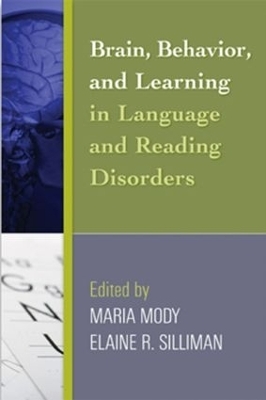
Brain, Behavior, and Learning in Language and Reading Disorders
Guilford Publications (Verlag)
978-1-59385-831-5 (ISBN)
- Titel ist leider vergriffen;
keine Neuauflage - Artikel merken
Grounded in cutting-edge research on brain–behavior relationships, this book explores how language and reading disorders develop--and presents exciting new approaches to examining and treating them. Experts from multiple disciplines investigate how children's learning trajectories in spoken and written language are shaped by the dynamic interplay of neurobiological, experiential, and behavioral processes. The volume includes innovative neuroimaging applications and other state-of-the-science techniques that help shed new light on childhood disorders such as dyslexia, language impairment, writing disabilities, and autism. Implications for evidence-based diagnosis, intervention, and instruction are discussed. Illustrations include five color plates.
Maria Mody, PhD, is a cognitive neuroscientist in the Department of Radiology at Massachusetts General Hospital and Harvard Medical School, specializing in developmental disorders of reading and language. She is a member of the faculty in the Health Sciences and Technology Program at the Massachusetts Institute of Technology, and also teaches in the Department of Communication Sciences and Disorders at Emerson College. Dr. Mody uses a variety of neuroimaging methods to examine the relationship between spoken language and reading in normal and atypical development. Her work is supported by funding from the National Institutes of Health and the Mental Illness and Neuroscience Discovery Institute in Albuquerque, New Mexico. She is a past Associate Editor of the Journal of Speech, Language, and Hearing Research and has published in a variety of journals. Elaine R. Silliman, PhD, is Professor Emeritus of Communication Sciences and Disorders and Cognitive and Neural Sciences at the University of South Florida. She is a Fellow of the American Speech-Language-Hearing Association (ASHA) and the International Academy for Research on Learning Disabilities. She also holds the Honors of the New York State Speech-Language-Hearing Association and the Distinguished Alumni Achievement Award from the Graduate Center of the City University of New York. Dr. Silliman is a past Editor of the ASHA journal Language, Speech, and Hearing Services in Schools.. Her research has appeared in a wide variety of journals, and she is the author or coauthor of 18 chapters and coeditor of five books. Dr. Silliman's current research interests include the development of academic language proficiency in children struggling with reading, writing, and spelling.
Part 1. New Frameworks for Understanding Language Impairment and Reading Disorders. M. Mody, E.R. Silliman, Introduction: The Nature of Interactions between Behavior, Brain, and Experience: Framing Multiple Perspectives. J.W. Gilger, M. Wilkins, Atypical Neurodevelopmental Variation as a Basis for Learning Disorders. J.L. Evans, Emergentism and Language Impairment in Children: It’s All about Change. J.T. Bruer, Critical Periods in Second-Language Learning: Distinguishing Phenomena from Explanations. Part 2. Brain–Behavior Relationships. M. Mody, E.R. Silliman, Introduction: The Language–Reading Interface: Associations and Dissociations within an Atypically Developing System. V.W. Berninger, Defining and Differentiating Dysgraphia, Dyslexia, and Language Learning Disability within a Working Memory Model. J. Windsor, K. Kohnert, Processing Measures of Cognitive–Linguistic Interactions for Children with Language Impairment and Reading Disabilities. D.A. Weber, W.D. Gaillard, Functional Neuroimaging Indices of Normal and Atypical Spoken Language. P.G. Simos, S. Sarkari, A.C. Papanicolaou, Magnetoencephalographic Indices of Brain Mechanisms for Language Comprehension. S.E. Shaywitz, J.R. Gruen, B.A. Shaywitz, Dyslexia: A New Look at Neural Substrates. B. Byrne, D.P. Shankweiler, D.W. Hine, Reading Development in Children at Risk for Dyslexia. Part 3. The Role of Experience. M. Mody, E.R. Silliman, Introduction: Learning to Read and Reading to Learn: The Interaction among Cognitive Capacity, Linguistic Abilities, and the Learning Environment. A. van Kleeck, E. Norlander, Fostering Form and Meaning in Emerging Literacy Using Evidence-Based Practice. K. Nelson, M.E. Arkenberg, Language and Reading Development Reflects Dynamic Mixes of Learning Conditions. E.R. Silliman, M. Mody, Individual Differences in Oral Language and Reading: It’s a Matter of Experience.
| Erscheint lt. Verlag | 24.9.2008 |
|---|---|
| Reihe/Serie | Challenges in Language and Literacy |
| Verlagsort | New York |
| Sprache | englisch |
| Maße | 156 x 234 mm |
| Gewicht | 696 g |
| Themenwelt | Geisteswissenschaften ► Psychologie ► Allgemeine Psychologie |
| Geisteswissenschaften ► Psychologie ► Verhaltenstherapie | |
| Medizin / Pharmazie ► Gesundheitsfachberufe ► Logopädie | |
| ISBN-10 | 1-59385-831-0 / 1593858310 |
| ISBN-13 | 978-1-59385-831-5 / 9781593858315 |
| Zustand | Neuware |
| Haben Sie eine Frage zum Produkt? |
aus dem Bereich


